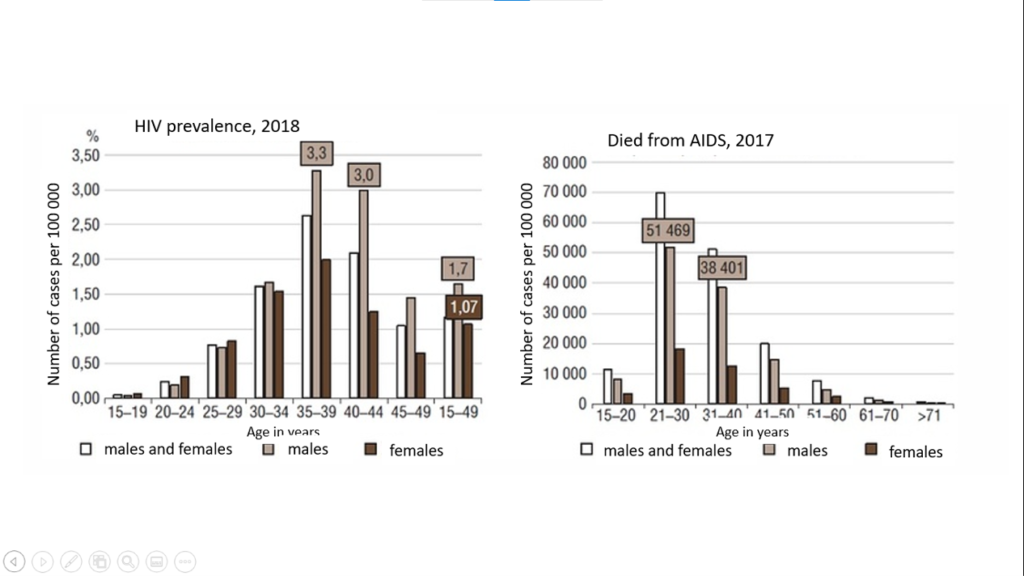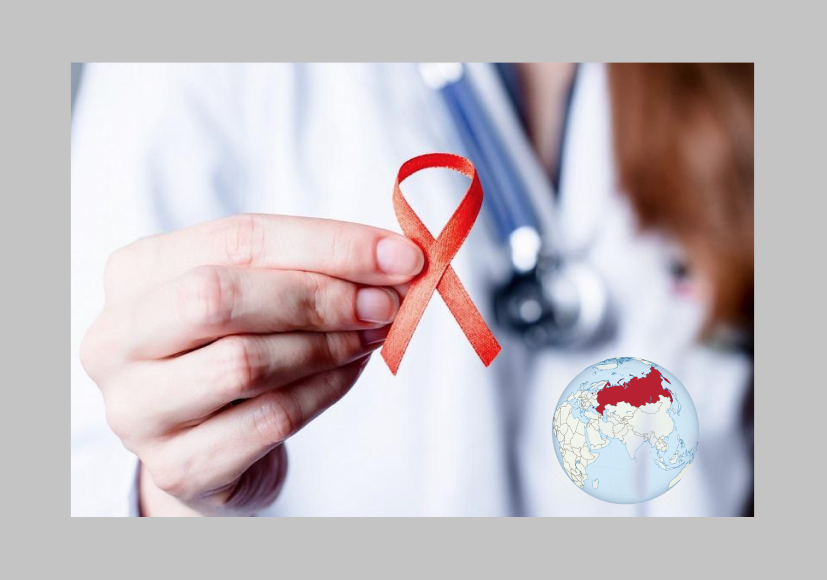A study shows that the state of socioeconomic state of a country is impacted by ART provision to HIV-positive people. Thus, a change of the scenario may help save Russia 317 billion rubles.
In the region of Eastern Europe and Central Asia (EECA) the HIV spread has not been stabilized; the epidemic level is not lowering.
According to UNAIDS (United Nations program on HIV/AIDS), in 2018, about 71% of all HIV-infected people in EECA were living in Russia.
The constant growth of number of HIV-infected in Russia is accompanied by significant mortality rate, which seriously affects the country’s demographics. At the same time, in the countries where more effective ART regimens are being used, the life expectancy of HIV-positive population increases, while mortality rate diminishes.
HIV in Russia today
According to the newsletters of Federal Scientific Medical Center (FSMC) of Rospotrebnadzor on AIDS Control and Prevention in 2018 and 2019, HIV prevalence is the highest among people of active working age.
It deserves mentioning that the prevalence of infection among 35- to 39-year-old males is almost twice as high as among females and reaches 3.0% to 3.3%. In general, in 2018 the disease prevalence among 15- to 49-year-old people was 1.7% in males and 1.07% in females.
The total mortality rate among HIV-infected is significantly higher in younger groups: it reaches 70 thousand deaths per year among 21- to 30-year-old people and 50 thousand deaths per year among 31- to 40-year-old people. The number of males of this age who died in 2017 was more than twice that of females.

According to Russian Federal Institute on AIDS Control and Prevention, at the end of 2019 only 48.5% of all people living with HIV were receiving therapy. This is equal to 68.9% of HIV-positive people on active observation.
Provided treatment regimens consisted mostly of first-generation drugs of poor quality, so viral suppression was reached only in 76.3% of patients receiving.
Regimens based on fixed combinations and once daily administration which would be more comfortable for patients and could improve ART therapy compliance, corresponded only to 2.2% of total purchases of ART medications.
The study
Growth of HIV prevalence and related mortality leads to socioeconomic issues: increased medical cost, increased industrial losses, and decreased work productivity. In addition, cumulative life expectancy and volume of able-bodied population are decreasing.
Meanwhile, the level of socioeconomic challenges is related to ART provision for people living with HIV.
OI Volkova, EO Kurilovich, and LD Popovich have conducted a study to assess the epidemiological consequences of HIV epidemics in Russia and evaluate socioeconomic losses using several scenarios of the therapy provision.
The study involved modelling of differentiated disease outcomes and costs depending on different algorithms and ART coverage for HIV-infected population in Russia, with quantitative and financial estimation of potential lost or saved life-years, for the mid-term period from 2019 to 2023.
Methodology
An epidemiological predictive model has permitted to observe changes in epidemiological consequences, ART-related costs, potential disease burden using different baseline factors.
Epidemiological strain related to HIV/AIDS was estimated based on available data for the infection spread dynamics in previous years as well as on prognosed numbers.
Number of new events was calculated based on retrospective official statistics of the disease frequency. Socioeconomic burden of HIV and potential reduction in losses were assessed on the base of predicted scenarios of epidemiological damage and costs of ART, which depend on the treatment coverage and used treatment regimens at baseline and during the prognosed period.
Results
If the existing algorithm of treatment maintains in mid-term:
- ART-related costs will increase by 59.4% to 2023.
- Control of the HIV epidemics will not be reached even in case of 60% or 90% treatment coverage of infected people.
- In 5 years, the number of people living with HIV will grow by 12.1%.
- In 3 years, the number of deaths among HIV-infected will grow by 35.4%.
Qualitative shift of the treatment and provision approaches would involve the following:
- Increasing the treatment coverage to 90% people living with HIV.
- Change of treatment algorithm by increasing the proportion of highly effective medications, including fixed combinations (3 drugs in 1 pill).
- Reaching viral suppression in 90% of treated people.
In 5 years, the described approach may potentially save 500 600 life-years, or 317.8 billion rubles in monetary equivalent.
Conclusion
The study, including the prediction and calculation of potential prevented damage, suggests that 90% treatment coverage in mid-term, along with optimized treatment regimens, may ensure much more noticeable social benefit than the current strategy.
Additional costs of new-generation ART drugs will be compensated by annually increasing efficacy of this approach. Cumulatively, it will result in lowering of HIV epidemics-related socioeconomic damage for Russian society.
Dmitriy Korenev
Based on: OI Volkova, EO Kurilovich, and LD Popovich. Potential socioeconomic damage by different scenarios of treatment provision and ART coverage levels for people living with HIV// Infectious diseases: news, opinions, education. 2020. Vol. 9, #2, pp. 8-17.
DOI: 10.33029/2305-3496-2020-9-2-8-17
Full text of the study in Russian
This article was prepared with the support of Oxfam in the Russian Federation
